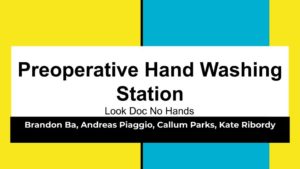Look Doc No Hands!

Creative Prototypes
I love meeting people and making connections.
My husband and I attended a dinner party three years ago and looked forward to making acquaintances and learning about our new community.
Our friends were encouraging and hopeful that we would find a comfortable niche in the Southwest after leaving the Midwest. We soon realized that many families inhabiting the town during the summer were escaping Houston’s heat and humidity. Such was the case for our hosts. The food was delicious, and our conversations were fascinating.
One of the guests happened to hear about our work in Ethiopia and that was how we made an exciting connection.
Matthew offered me a sample of his carrot greens pesto and introduced himself. We shared stories about living and working in Ethiopia. He mentioned having returned from Addis Ababa, Ethiopia, quite recently.
His work involved teaching and constructing prototypes from readily available materials. The engineering students at Addis Ababa University were participants in his seminar.
https://youtu.be/fYrbXCwhTC8
Design and Build: Medium Fidelity
The Freshman Engineering class at Rice University began work on “Look Doc No Hands” in August 2018. The team started the process of constructing the first medium-fidelity prototype of a hands-free handwashing sink. The main objectives were to integrate each component and get a sense of what does and doesn’t flow from the initial planning. The frame was made of PVC, initially. This was changed to a sturdier and stronger material. The reservoir of the initial prototype held 5 gallons, the goal was to create capacity for 10 to 30 gallons of water. The flow rate was a success at around 50 fluid ounces per minute.
Design and Build: High Fidelity
The final prototype included a wooden frame connected with screws. The wheels were four three-inch caster wheels with an integrated braking mechanism placed on the corners of the bottom of the frame. The three-inch caster wheels could sustain a weight of 440 pounds!
A yellow 20-gallon cylindrical reservoir, twenty-two, and a half inches in height and twenty-one inches in diameter was used for the water. It turned out that 20-gallons of water promoted a more regular refilling of the water, allowed the water to sit for less time, and thus, reducing the risk of contamination.
Eight-inch long siphon pumps with three-inch diameters were fastened into place using zip-ties. A dual foot pedal mechanism that allowed two pumps to be depressed simultaneously to achieve at least a 1.2-gallon/minute flow rate. All tubing (norprene tubing and PVC hose piping ) functioned to move the water from the bottom of the reservoir (PVC pipe) to the top. The two fifty-four-inch norprene tubes attached the inlet side of the siphon pumps to the reservoir.
https://rice.mediaspace.kaltura.com/media/Look_Doc_No_Hands_-_20181129_111733_12/1_w2gx2dnd
Sister Aklesia Sanitation Solutions, (SASS) 2021
This year, a different class, taught by Dr. Deirdre Hunter, will focus on function, project testing, and implementation. The project is now the Sister Aklesia Sanitation Solutions, (SASS). Team SASS will conduct rigorous testing and implementation. Once the tests are completed, a manual will be assembled with details and design specifications for materials easily obtained in Ethiopia.
Special thanks to Dr. Matthew Wettergreen, PhD., Associate Teaching Professor at the Oshman Engineering Design Kitchen (ODEK) and Director of the Global Medical Innovation (GMI) ProgramThank You Rice University School of Engineering and ODEK
https://bioengineering.rice.edu/academics/masters-programs/mbe-global-medical-innovation
Special Thanks to Dr. Deirdre Hunter, PhD. Oshman Engineering Design Kitchen